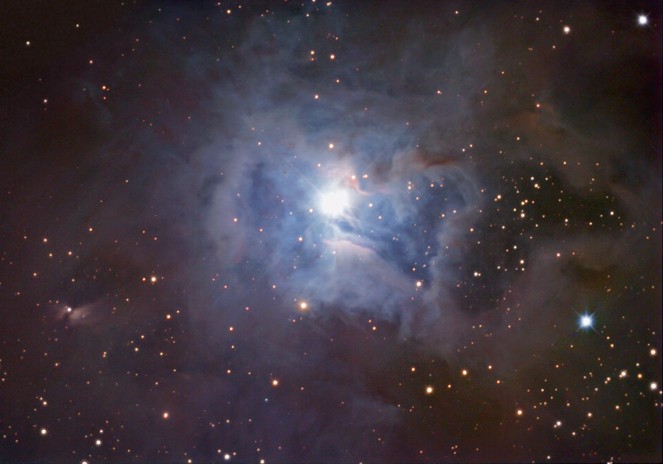
|
Credit & Copyright: Image - Jim Misti
(acquisition),
Robert Gendler
(processing)
Explanation:
Like delicate cosmic petals, these clouds of interstellar
dust and gas have blossomed 1,300 light-years away in the fertile
star fields of the constellation Cepheus.
Sometimes called the Iris Nebula and dutifully
cataloged as NGC
7023, this is not the only nebula in the
sky to evoke the imagery of flowers.
Still, the
beautiful
digital image shows off the Iris Nebula's range of colors and
symmetries in impressive detail.
Within the Iris, dusty nebular material surrounds a massive, hot,
young star in its formative years.
Central filaments of cosmic dust glow with a reddish photoluminesence
as some dust grains
effectively
convert the star's invisible
ultraviolet
radiation to visible red light.
Yet the dominant color of the nebula is blue,
characteristic
of dust grains reflecting starlight.
Dark, obscuring clouds of dust and cold molecular gas are also
present and can lead the eye to see other
convoluted and
fantastic shapes.
Infrared observations
indicate that this nebula may contain
complex carbon molecules known as
PAHs.
As shown here, the Iris Nebula is about 6 light-years across.
|
January February March April May June July August September October November December |
| ||||||||||||||||||||||||||||||||||||||||||||||||
NASA Web Site Statements, Warnings, and Disclaimers
NASA Official: Jay Norris. Specific rights apply.
A service of: LHEA at NASA / GSFC
& Michigan Tech. U.
Based on Astronomy Picture
Of the Day
Publications with keywords: reflection nebula - emission nebula - dark nebula - NGC 7023
Publications with words: reflection nebula - emission nebula - dark nebula - NGC 7023
See also:
- APOD: 2025 November 19 Á Chamaeleon Dark Nebulas
- APOD: 2025 September 19 Á The NGC 6914 Complex
- APOD: 2025 September 10 Á The Great Lacerta Nebula
- APOD: 2025 July 21 Á Cats Paw Nebula from Webb Space Telescope
- APOD: 2025 July 16 Á The Rosette Nebula from DECam
- APOD: 2025 July 5 Á Ou4: The Giant Squid Nebula
- APOD: 2025 June 26 Á The Seagull Nebula
